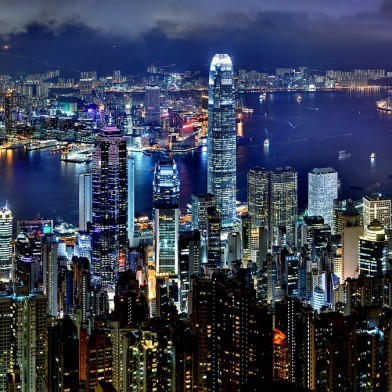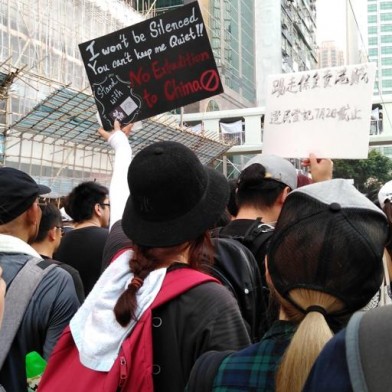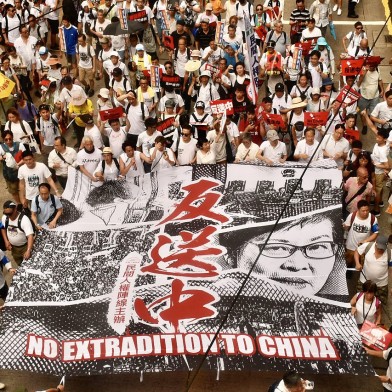How did protests against proposed changes to extradition laws swell to Hong Kong’s worst political crisis since the 1997 handover? Here is a timeline of key events.
February 2019: Hong Kong's Security Bureau proposes extradition law amendments that would allow criminal suspects to be handed over to countries and territories not covered by existing extradition agreements, including mainland China.
March 31: Up to 12,000 take to the streets of Hong Kong (though police estimate the crowd at 5,200 at its peak) in the first demonstration against the extradition plan, organised by the Civil Human Rights Front.
April 3: The draft extradition bill has its first reading at the Legislative Council.
April 28: A second march against the bill attracts up to 130,000 protesters (though police put the figure at 22,800) in one of the city's biggest demonstrations since the Umbrella Movement in 2014.
April 29: Chan Tong-kai, a Hong Kong man who admitted to killing his pregnant girlfriend while on holiday in Taiwan, is sentenced to 29 months in prison on money laundering charges. The Hong Kong government uses the case as an example of why the extradition bill is needed — police were unable to charge Chan with murder for a crime committed in Taiwan.
May 11: Fighting erupts in Hong Kong’s legislature as pro-Beijing and pro-democracy lawmakers clash over the proposed bill. Several are injured and one is taken to hospital.
May 30: The Hong Kong government announces new concessions to the extradition bill, including that only suspects facing serious crimes with a minimum punishment of at least seven years, instead of three years, will be extradited.
June 6: Around 3,000 lawyers, dressed in black, march in silence to the government headquarters in a rare protest from the legal sector against the extradition bill.
June 9: More than a million Hong Kongers march in protest of the extradition bill, in the city’s largest demonstration since the handover in 1997 (police estimate the crowd at 270,000). Hong Kong chief executive Carrie Lam vows to push ahead with the bill, with its second reading debate scheduled for June 12.
June 12: Police use tear gas and rubber bullets to push back thousands of protesters who have surrounded the government headquarters in central Hong Kong. The city’s police commissioner calls the demonstration a “riot”. As a result of the commotion, the second reading of the extradition bill is postponed.
June 15: Lam announces she has decided to indefinitely suspend the extradition bill.
June 16: Two million Hong Kongers return to the streets (police said it was 338,000), calling for the bill to be withdrawn permanently. Protesters also demand Lam’s resignation, and ask the government to stop characterising the protest as a “riot”. Lam issues an apology in a written statement.
June 18: Lam apologises again, this time in the form of a press conference, but does not concede to demands that the bill be withdrawn entirely.
June 21: Thousands of protesters converge on Hong Kong's police headquarters, demanding that officials apologise for the police's handling of the June 12 demonstration.
July 1: Hong Kong marks the 22nd anniversary of its handover to China. Tens of thousands of protesters march peacefully, but the city also experiences violence as a smaller group storms and vandalises the Legislative Council building.
July 13: Thousands of protesters clash with police in the border town of Sheung Shui in the New Territories. They were demonstrating against "parallel traders" who buy up duty-free goods in Hong Kong and sell them in mainland China.
July 14: Thousands march against the extradition bill in the Sha Tin area of the New Territories. After the march, protesters and riot police clash inside a shopping mall, with 22 taken to hospital and more than 40 arrested.
July 20: Thousands gather in central Hong Kong to show their support for Hong Kong authorities and police.
July 21: Hundreds of thousands march towards the government buildings. Police fire tear gas and rubber bullets to disperse protesters who have surrounded the Beijing liaison office. As protesters make their way home, a group of masked men dressed in white clothes and armed with sticks attack protesters and other commuters inside the Yuen Long MTR station.
July 24: China's Ministry of National Defence releases its new national defence white paper. In comments made alongside its release, a People’s Liberation Army spokesman says forces stationed in Hong Kong could be deployed to maintain public order in the city.
July 26: Protesters stage a demonstration in the arrivals hall of Hong Kong airport.
July 28: Police fire tear gas and rubber bullets at protesters outside the Beijing liaison office.
July 29: China’s top office for handling Hong Kong, the Hong Kong and Macau Affairs Office, holds a press conference in Beijing on the situation. It's the first time the office has spoken publicly about the territory since the handover in 1997.
August 1: China's military releases a dramatic video on Weibo which shows armed troops carrying out drills and cracking down on protestors.
August 5: Citywide protests disrupt public transport and cause more than 150 flights to be cancelled. Police fire multiple rounds of tear gas. Lam warns the city is “on the verge of a very dangerous situation”.
August 6: The Hong Kong and Macau Affairs Office holds a second press conference, warning protesters not to underestimate the strength of the central government. Police fire tear gas in the working class Sham Shui Po neighbourhood after a student leader is arrested for possession of “offensive weapons” – laser pointers.
August 8: New Zealand joins a number of countries in raising its travel advisory level for Hong Kong, warning that visitors should “exercise increased caution” due to civil unrest in the city.
August 11: A young woman is shot in the eye with a beanbag round during a clash in Tsim Sha Tsui. Her image becomes a new symbol of the movement, along with the rallying cry "an eye for an eye".
August 12: Thousands of protesters at Hong Kong airport cause hundreds of flights to be cancelled. Beijing likens the protesters’ actions to “terrorism”.
August 13: Hong Kong airport cancels flights for a second day as the demonstration there continues. Riot police use pepper spray and batons to clear the protesters. A mainland Chinese journalist is tied up and beaten by protesters.
August 14: Protesters apologise on social media for the airport disruption, admitting that some demonstrators had "overreacted".
August 16: Cathay Pacific, Hong Kong's flag carrier, announces that its chief executive Rupert Hogg has resigned. The airline faced pressure from Beijing after some of its employees participated in the protests.
August 18: Up to 1.7 million people (police put the figure at 128,000) return to the streets of Hong Kong in a renewed show of solidarity for the movement. For the first time in weeks, the protest remains peaceful.
August 21: Thousands of demonstrators stage a sit-in at Yuen Long MTR station in support of the victims of the 21 July mob attacks at the station. Alibaba, China’s biggest e-commerce company, delays its Hong Kong listing of up to $15 billion.
August 23: Around 5,000 accountants march silently to Government HQ. Later, more than 200,000 people create three human chains along the three main MTR lines on both sides of Hong Kong Harbour.
August 25: Police use water cannon, and a live round is fired for the first time, during violent protests in Tsuen Wan. The warning shot is fired into the air after police are chased and cornered by protesters weilding sticks and rods.
August 30: Several prominent pro-democracy activists and lawmakers are arrested, including Joshua Wong and Agnes Chow.
September 1: Police are criticised after violently tackling suspected protesters after another large street march. Images posted to social media show police hitting people with batons and using pepper spray on an MTR train. Protesters light fires and attack LegCo, Hong Kong's parliament, and police respond with live warning shots, water cannon , tear gas and rubber bullets.
September 2: Lam says she has caused “unforgivable havoc” and would quit if she could, according to a leaked recording of remarks she makes to business people.
September 3: Lam says she had never asked the Chinese government to let her resign.
September 4: Lam announces she will formally withdraw the controversial extradition bill, which sparked the protests .Protesters say it is too little,too late and insist their other four demands must be met:
- The withdrawal of the "riot" description used about the 12 June protests
- An amnesty for all arrested protesters
- An independent inquiry into alleged police brutality
- Universal suffrage in elections for Hong Kong's chief executive (the territory's leader), and Legislative Council.
September 17: Lam announces she will hold talks with the community to try to ease tensions.
September 26: Protesters trap Lam in a stadium for hours after her first public “open dialogue”.
October 1: Hong Kong is rocked by the most widespread unrest since the protests began as China’s Communist Party rulers celebrate the 70th anniversary of the founding of the People’s Republic. Police shoot an 18-year-old protester in the shoulder. Some 1,400 tear gas rounds are fired that day.
October 4: Lam announces colonial-era emergency powers to ban face masks, sparking violent protests. A police officer shoots a 14-year-old boy in the thigh.
October 5: The ban on face masks officially begins - and is largely ignored.
October 16: Lam abandons her annual policy speech amid lawmakers’ jeers. Prominent rights activist Jimmy Sham is attacked and beaten on the street by four men wielding hammers and knives.
October 23: The extradition bill is formally withdrawn by LegCo.
October 29: Pro-democracy activist Joshua Wong is barred from standing in district elections.
October 31: Preliminary data shows Hong Kong slipped into recession for the first time in a decade in the third quarter.
November 2: Protesters attack and vandalise China’s official Xinhua news agency, smashing doors, setting fires and throwing paint.
November 3: A male pro-China supporter bites off part of a politician’s ear and slashes several people with a knife during a rally at a shopping mall rally
November 4: University student Chow Tsz-lok, 22, is seriously injured after a fall from the third to the second floor of a parking building amid chaotic confrontations between police and protesters.
November 6: A knife-wielding man attacks pro-Beijing lawmaker Junius Ho.
November 8: Student Chow Tsz-lok dies. The news causes shock and grief across the city, sparking a fresh wave of violent protests.
November 11: Police fire live rounds at protesters on the eastern side of Hong Kong island, wounding one person.
- By mid November,according to the South China Morning Post, police had fired more than 7,500 canisters of tear gas at protesters, 3,500 rounds of rubber bullets and more than a dozen live rounds. Some 4,000 arrests had been made. Meanwhile, numerous projectiles had been hurled at police, including corrosive liquid and at least 350 petrol bombs.
This article was last updated on November 12.
Main image: Wikimedia Commons
- Asia Media Centre


